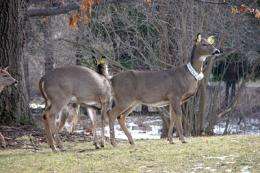Research explores options for deer population control

(PhysOrg.com) -- Whitetail deer bounding across campus is an all-too-familiar scene. In recent years, however, Cornell's deer population has skyrocketed, leading to such hazards as collisions with cars, destruction of agricultural research plots and reduced biodiversity in natural areas and plant collections.
In response, Cornell researchers began a five-year research project to reduce "deer abundance and associated impacts" by 75 percent on central campus and 50 percent in less developed outlying areas. The group issued a progress report in July as the study concluded its second year.
The innovative study -- the first to combine controlled hunting with doe sterilization -- uses different methods for managing deer in environments that range from urban to rural.
"Deer overpopulation is not a problem isolated to Cornell," said Paul Curtis, associate professor of natural resources and director of Cornell's Integrated Deer Research and Management Study. "Many communities in the Northeast and New York have been struggling with this issue for years. If successful, our program could have applications for other areas facing this problem."
On central campus, where hunting is not feasible or legal, researchers use infrared-triggered cameras to observe movement patterns and determine survival rates. They surgically sterilized 58 does, which the researchers hope will result in a gradual thinning of the herd. Faculty and students at Cornell's College of Veterinary Medicine are assisting with the spays, while also studying novel drug combinations to safely subdue and capture deer. Of the sterilized does, 39 were fitted with radio collars to monitor fawning rates, movement patterns, home-range size and survival rates.
Controlled hunting, on the other hand, has been allowed in rural and peripheral areas of campus as a way to prevent outside deer from entering the core campus. Study leaders have implemented an "Earn-a-Buck" program, which allows hunters to shoot at an antlered deer if they have first taken two does. The university has permitted bow and firearm hunting in these open spaces for decades, but now more closely regulates hunter activity under the new program.
In fall 2008, hunters harvested 69 deer (49 does, 10 female fawns, 10 bucks), the first under the "Earn-A-Buck" program.
Sportsmen are not permitted, however, to fire at deer wearing radio collars, said Jay Boulanger, extension associate and deer program coordinator. He added that sterilized doe have a limited home range and are unlikely to wander into hunting grounds.
"We are not using culling to reduce Cornell's deer population," said Boulanger, who noted that culling is being discussed as an option for deer management in Cayuga Heights, whose program is unrelated to Cornell's. "Culling uses trained sharpshooters to remove large numbers of deer in a short period of time."
Next, the researchers will evaluate whether their integrated deer management approach is effective in meeting local objectives and could be used as a template for other campuses and communities. They plan to submit the study results for publication in peer-reviewed literature.
Provided by Cornell University (news : web)















